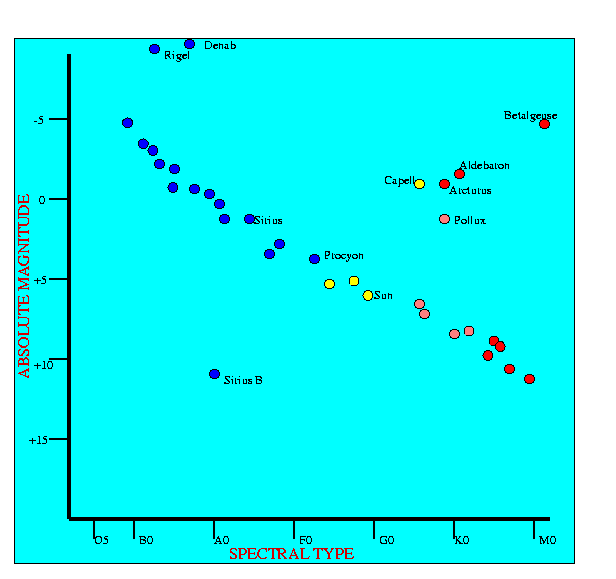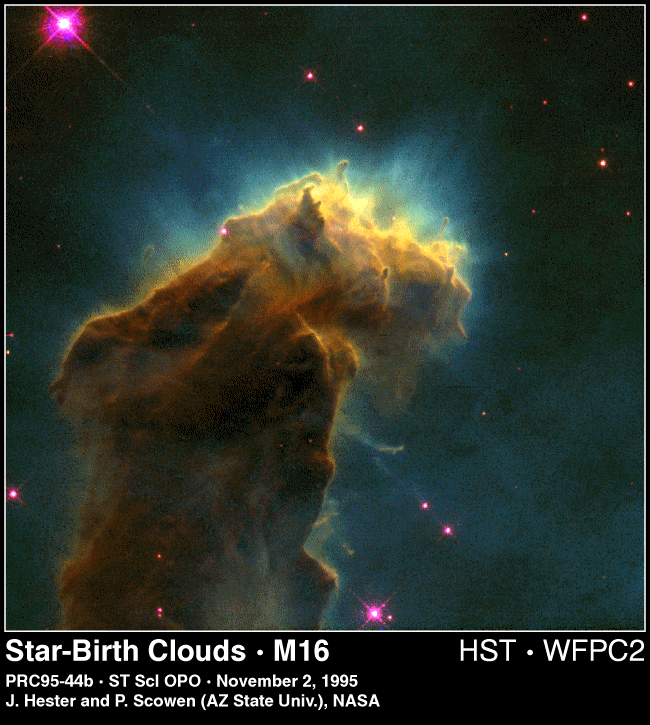cold nebulae are dark and are often only visable when there are hot
areas behind
(or in radio wave pictures..)
Stars are formed in Dark Nebulae. As the protostars contract they heat up.
If the clump of gas has enough mass eventually pressures/temperatures in the
core will be high enough that fusion will occur. If the mass is too low
pressures
will never quite be high enough for fusion. The theoretical limit is that
M > 0.08 Ms
for a star to be born. If M < 0.08 Ms
a dense ball of gas will
form -
this is a brown dwarf or failed star. This is quite like jupiter!
(not
quite because jupiter has a solid core).
Some nebulae are mixtures of dark regions and regions where stars have
formed. These can look very spectacular.
A list of these Emission nebulae is
Pictures of Emission Nebula
Horsehead Nebula ,
Trifid (close-up) ,
M42 (Orion) ,
The
"Trapezium"
(young stars) in the heart of Orion
Starbirth in M16 (Eagle Nebula):
a Full view ,
closer view
and close up
| Region | i Distance from Earth (Lyr) | Size (Lyr) |
Mass (solar Massess ) | Density (atoms/cm^3) |
Orion Nebula | 1500 | 16 | 300 | 600 |
| Eagle Nebula (M16) | 6000 | 20 | 500 | 90 |
| Omega Nebula (M17) | 5000 | 30 | 1500 | 120 |
| Lagoon Nebula (M8) | 4000 | 30 | 1000 | 80 |
| Triffid Nebula (M20) | 3000 | 12 | 150 | 100 |
|
Evolutionary Tracks
In the process of forming, a star will evolve and move across the HR
diagram towards the main sequence. For a protostar the mass of the
sun, initially the protostar is powered just by collapse - this
however enough to give off considerable light especially since the
protostar is diffuse. Surprisingly as it contracts it become brighter
but less luminous (its surface area is much less). The track then
moves down and to the left. When hydrogen burning gets going it will
move upwards and rightwards towards the main sequence. Arrival at the
main sequence indicates that the star has stabalised and contraction
has ceased. Larger stars have a more horizontal path.

|
| HR diagram
|
| Evolutionary track
of M=1 protostar
|
| other tracks
|
|
T-Tauri stars or Herbig-Haro Objects
Steller birth can be traumatic. We looked at the violent jets that
young stars can emit.
Image of HH objects
If the mass
of a protostar is less than 0.08 solar masses then the protostar never
reaches temperatures/densities to ignite the nuclear fusion. In this
case we end up with a faint (still warm from its contraction)
brown dwarf or failed star.
A small star just above this limit is called a red dwarf .
Red dwarfs are true stars burning hydrogen but they are faint and
have an extremely long lifetime. Brown dwarfs are rather like jupiter
© Dave Dunbar 2020






